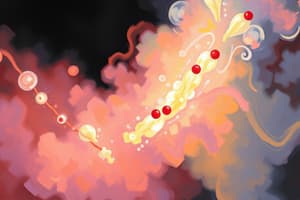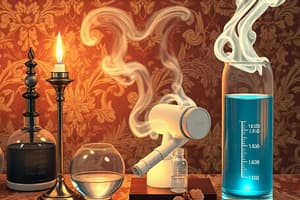Podcast
Questions and Answers
What is the primary reason gases can be compressed easily?
What is the primary reason gases can be compressed easily?
- Particles are in fixed positions.
- Particles are closely packed together.
- Particles have negligible volume.
- Particles are widely separated and have high energy. (correct)
The pressure exerted by a gas is the result of collisions of gas particles with the walls of their container.
The pressure exerted by a gas is the result of collisions of gas particles with the walls of their container.
True (A)
What is the equation that represents Boyle's Law?
What is the equation that represents Boyle's Law?
PV = constant
At standard atmospheric pressure, 1 atm is equal to _____ torr.
At standard atmospheric pressure, 1 atm is equal to _____ torr.
Match the following laws with their definitions:
Match the following laws with their definitions:
What happens to the volume of a gas if its temperature is increased while keeping pressure constant?
What happens to the volume of a gas if its temperature is increased while keeping pressure constant?
Gases have a definite shape and volume.
Gases have a definite shape and volume.
What unit is used to measure pressure in the metric system?
What unit is used to measure pressure in the metric system?
What is the compressibility factor of an ideal gas?
What is the compressibility factor of an ideal gas?
Gases behave non-ideally at high temperatures and low pressures.
Gases behave non-ideally at high temperatures and low pressures.
What is the primary characteristic of the compressibility factor for real gases at very high pressures?
What is the primary characteristic of the compressibility factor for real gases at very high pressures?
According to the van der Waals equation, the term 'b' measures the __________ occupied by gas molecules.
According to the van der Waals equation, the term 'b' measures the __________ occupied by gas molecules.
Match the van der Waals constants with their descriptions:
Match the van der Waals constants with their descriptions:
At low pressures, how do gases behave?
At low pressures, how do gases behave?
Boyle’s Law accurately predicts gas behavior under all pressure conditions.
Boyle’s Law accurately predicts gas behavior under all pressure conditions.
What phenomenon occurs due to intermolecular forces in gases at high pressures?
What phenomenon occurs due to intermolecular forces in gases at high pressures?
What is the relationship defined by Avogadro's Law?
What is the relationship defined by Avogadro's Law?
At standard temperature and pressure (STP), one mole of gas occupies 22.4 L.
At standard temperature and pressure (STP), one mole of gas occupies 22.4 L.
What is the ideal gas equation?
What is the ideal gas equation?
The standard temperature is __ degrees Celsius.
The standard temperature is __ degrees Celsius.
Match the gas law with its corresponding principle:
Match the gas law with its corresponding principle:
What is the molar volume of a gas at standard conditions?
What is the molar volume of a gas at standard conditions?
In a gas mixture, each gas behaves as if it is the only gas present in the container.
In a gas mixture, each gas behaves as if it is the only gas present in the container.
The compressibility factor measures how much a gas deviates from __ gas behavior.
The compressibility factor measures how much a gas deviates from __ gas behavior.
Flashcards
Gas pressure
Gas pressure
Force exerted by gas molecules on container walls.
Boyle's Law
Boyle's Law
At constant temperature, pressure and volume of a gas are inversely proportional.
Charles's Law
Charles's Law
At constant pressure, volume of a gas is directly proportional to its temperature (in Kelvin).
Gas
Gas
Signup and view all the flashcards
Temperature (in gas)
Temperature (in gas)
Signup and view all the flashcards
Pressure (in gas)
Pressure (in gas)
Signup and view all the flashcards
Ideal Gas Law
Ideal Gas Law
Signup and view all the flashcards
Units of pressure
Units of pressure
Signup and view all the flashcards
Kelvin Temperature
Kelvin Temperature
Signup and view all the flashcards
Avogadro's Law
Avogadro's Law
Signup and view all the flashcards
Standard Temperature and Pressure (STP)
Standard Temperature and Pressure (STP)
Signup and view all the flashcards
Ideal Gas Equation
Ideal Gas Equation
Signup and view all the flashcards
Dalton's Law of Partial Pressures
Dalton's Law of Partial Pressures
Signup and view all the flashcards
Mole Fraction
Mole Fraction
Signup and view all the flashcards
Partial Pressure
Partial Pressure
Signup and view all the flashcards
Real Gases
Real Gases
Signup and view all the flashcards
Compressibility Factor
Compressibility Factor
Signup and view all the flashcards
Ideal Gas
Ideal Gas
Signup and view all the flashcards
Van der Waals Equation
Van der Waals Equation
Signup and view all the flashcards
Van der Waals constant 'a'
Van der Waals constant 'a'
Signup and view all the flashcards
Van der Waals constant 'b'
Van der Waals constant 'b'
Signup and view all the flashcards
Non-ideal gas behavior
Non-ideal gas behavior
Signup and view all the flashcards
Ideal conditions
Ideal conditions
Signup and view all the flashcards
Study Notes
Gases
- Gases expand to fill their containers.
- Gases are highly compressible.
- Gases have extremely low densities.
- Gases are mainly composed of nonmetallic elements with simple formulas and low molar masses.
- Two or more gases form a homogeneous mixture.
Models for States of Matter
- Gas: Widely separated particles in continuous, rapid, disordered motion.
- Liquid: Particles in contact, able to move past each other.
- Solid: Particles in contact, unable to move past each other.
Properties Defining a Gas Sample
- Temperature: Average velocity of gas constituents.
- Volume: Size of the container.
- Amount: Number of moles (n).
- Pressure: Force exerted on container walls by gas constituents.
Pressure
- Pressure is the amount of force applied to an area (P = F/A).
- Pascal (Pa) is the SI unit of pressure (1 Pa = 1 N/m²).
- 1 bar = 10⁵ Pa = 100 kPa.
- Standard atmospheric pressure is the normal atmospheric pressure at sea level.
- 1.00 atm = 760 torr = 760 mmHg
Boyle's Law
- At constant temperature, gas volume is inversely proportional to pressure.
- P₁V₁ = P₂V₂
Charles's Law
- At constant pressure, gas volume is directly proportional to absolute temperature.
- V₁/T₁ = V₂/T₂
Avogadro's Law
- At constant temperature and pressure, gas volume is directly proportional to the number of moles.
- V₁/n₁ = V₂/n₂
Standard Conditions of Temperature and Pressure (STP)
- Standard temperature: 0°C = 273 K.
- Standard pressure: 1 atm = 760 mmHg.
- One mole of gas occupies 22.4 L at STP (molar volume).
Ideal Gas Equation
- PV = nRT
- P = pressure, V = volume, n = moles, R = ideal gas constant, T = temperature.
- R has various values depending on the units used for pressure, volume, and temperature such as: L-atm /mol-K, J/mol-K, etc.
Dalton's Law of Partial Pressures
- The total pressure of a mixture of non-reacting gases is the sum of the partial pressures of each gas.
- Ptotal = P1 + P2 + P3 + ...
Mole Fraction
- Mole fraction (Xᵢ) is the ratio of moles of a component to the total moles in a mixture.
- X₁ = n₁/ntotal
- Partial pressure of a gas (P₁) is given by P₁ = X₁Ptotal
Non-ideal (Real) Gases
- Real gases deviate from ideal gas behavior at high pressures or low temperatures.
- Compressibility factor(Z) quantifies this deviation: Z = PV/nRT. For ideal gases, Z =1
- Intermolecular forces and molecular volume are important for real gases.
The van der Waals Equation
- (P + a(n/V)²)(V – nb) = nRT
- a and b are van der Waals constants which correct for intermolecular forces and the finite volume of the gas molecules respectively.
Studying That Suits You
Use AI to generate personalized quizzes and flashcards to suit your learning preferences.



